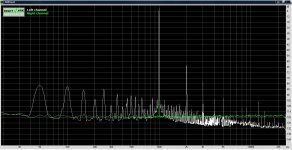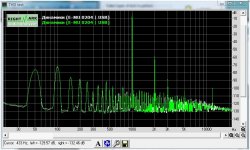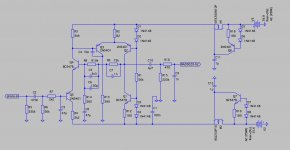Member
Joined 2009
Paid Member
I love designing gain stages, my passion to date has been power amps, lots of gain and lots of power. I've ignored that a bit on this thread because it won't go on this first board (not enough space for sure). Anyhow, would love some contributions. I have in my own mind that there could be more than one gain stage included, just for fun. One might be the NAC gain stage, afterall one of the goals was the Naim sound. Another could be a triode gain stage, although I'm not for sure going to squeeze some tubes into this box it's still an idea. My TGM11 power amp has a feedforward (no feedback) gain stage at the front but that might be a bit too controversial.
One might be the NAC gain stage, afterall one of the goals was the Naim sound.
As a 4 Ampere medium power transistor, BD437 would have less resistance in the base area than 5 ZTX384 in the NAC20.
If the signal current is split 5 ways over smaller base areas consider the affect on noise.
From memory a suitable transistor from the same era was BFW16A - that came to light in Elektor magazine.
Looking back through some old audioXpress issues a contributor measured the relative noise of some commonly available transistors for noise in a moving coil head amplifier - as follows
NPN BC639 Motorola 66, BC489A Motorola 71, MPSA42 On Semiconductor 73
PNP BC878 Siemens 32, BC880 Siemens 33, BC636 Motorola 58, BC640 Motorola 65.
The subject circuit involves 6 transistors in full complentary symmetry.
The author tested some transistors from other makers with the same part numbers -for instance BC639 from one of these rated 75.
I have omitted the less good results which include 2N4401 and 2N4403.
The information comes from a one page article. I am happy to send details if anyone is interested.
I think the Diamond buffer with a very simple gain stage would surpass most op amps if we were daft enough to use our ears. The L0002 which Ti were so kind to describe has an input impedance of 184K ( ?? ). This should mean the linearity of a very simple gain stage would be excellent even if using a resistor load and 60V. With CCS load I really doubt any real distortion of note. If 2nd was -80dB I would beg you to stop at that. You have a chance of the sound you want rather than a contest to be like other designs. Remember Naim designs were higher in 2nd than most.
To do what Self does is to me like eating under ripe fruit perhaps with the illussion it is better for us. When he says we shouldn't allow any distortion that we easilly can illiminate I wonder if he ever thought of music. That's like not playing an organ peddle when we should. If the second is above the third as a single transistor dictates a major reduction in musical distortion is avoided. If distortion is added in proportion to the real musical harmonics it will just be louder. If a distortion harmonic is removed that was in the ideal order then the higher orders become louder. It isn't rocket science.
The Tube Cad Mighty Diamond showed the Diamond Buffer can have ideal harmonics. As a Tube guy he wouldn't think to say as it is the goal of tube designs to have the second harmonic in the right proportions. Transistor people tell themselves tube guys love amps with only second harmonic. That's as far from the truth as you can get and isn't really possible in most cases. What was really meant was the higher order distortions were below lets say a - 60 dB level so were hard to measure in 1956.
To do what Self does is to me like eating under ripe fruit perhaps with the illussion it is better for us. When he says we shouldn't allow any distortion that we easilly can illiminate I wonder if he ever thought of music. That's like not playing an organ peddle when we should. If the second is above the third as a single transistor dictates a major reduction in musical distortion is avoided. If distortion is added in proportion to the real musical harmonics it will just be louder. If a distortion harmonic is removed that was in the ideal order then the higher orders become louder. It isn't rocket science.
The Tube Cad Mighty Diamond showed the Diamond Buffer can have ideal harmonics. As a Tube guy he wouldn't think to say as it is the goal of tube designs to have the second harmonic in the right proportions. Transistor people tell themselves tube guys love amps with only second harmonic. That's as far from the truth as you can get and isn't really possible in most cases. What was really meant was the higher order distortions were below lets say a - 60 dB level so were hard to measure in 1956.
BD437 is one of the line-items in The Art Of Electronics, 3rd edition, transistor noise shootout. Table 8.1a, page 501. BD437's measured noise is stunningly small, and the tabulated value of Early voltage is stunningly big. After reading that in AOE3, I bought a dozen parts to play with on the curve tracer (post #175). Download the datasheet and take a look.
BD437 is one of the line-items in The Art Of Electronics, 3rd edition, transistor noise shootout. Table 8.1a, page 501. BD437's measured noise is stunningly small, and the tabulated value of Early voltage is stunningly big. After reading that in AOE3, I bought a dozen parts to play with on the curve tracer (post #175). Download the datasheet and take a look.
I was interested to read the bit about early voltage capability of BD437 in your NPN Quasi Saturation thread last year having bought some to use for a low noise stage a few years earlier. I thought this a good bet - stunningly so on measurement is welcome news.
For discrete design if one is serious I think it is useful knowing which device to use and what if any differences there may be in equivalent part numbers made by different manufacturers.
One can look at manufacturers datasheets and not seeing any differences assume these are as good as each other.
Greetings! A small lyrical digression, well, or somewhere near ... Here is roughly what the spectrum looks like for a modern SE amplifier: 6N8S (6SN7) - 6P6S (6V6) - EML520. Measured with an output power of about 5W.The Tube Cad Mighty Diamond showed the Diamond Buffer can have ideal harmonics. As a Tube guy he wouldn't think to say as it is the goal of tube designs to have the second harmonic in the right proportions. Transistor people tell themselves tube guys love amps with only second harmonic. That's as far from the truth as you can get and isn't really possible in most cases. What was really meant was the higher order distortions were below lets say a - 60 dB level so were hard to measure in 1956.
Attachments
Probably, it is not always possible to curb the means of measurement. As an example, I can provide an option where such a breakdown is almost not observed. But, the main thing is the nature of the "classical" (or almost such) spectrum.
Is this without nfb?
Member
Joined 2009
Paid Member
additional regulator for phono section ?
I do like tubes !
But attention moving back to Board-1 and the MM phono section.
In LTSpice this phono section has atrocious PSRR, at least it's clearly bad at low frequencies and improves somewhat at high frequencies. Although there is a shunt regulator on the board, it feeds several circuits. I thought it worth considering additional power rail isolation for the phono section. It doesn't swing a lot of current because it's in Class A and will be driving a high impedance buffer which means not a lot of current variation on the power rails. A simple cap-multiplier provides a very meaningful improvement in low frequency power-rail isolation at relatively little cost. See attached - ignore the FET part numbers, I just 'grabbed' some parts from the Spice library; in practice I'd use some nice SMD FETs. The advantage of FET over BJT is very high gate impedance (vs base impedance) allowing for a higher PSRR.
Thoughts ?
I do like tubes !
But attention moving back to Board-1 and the MM phono section.
In LTSpice this phono section has atrocious PSRR, at least it's clearly bad at low frequencies and improves somewhat at high frequencies. Although there is a shunt regulator on the board, it feeds several circuits. I thought it worth considering additional power rail isolation for the phono section. It doesn't swing a lot of current because it's in Class A and will be driving a high impedance buffer which means not a lot of current variation on the power rails. A simple cap-multiplier provides a very meaningful improvement in low frequency power-rail isolation at relatively little cost. See attached - ignore the FET part numbers, I just 'grabbed' some parts from the Spice library; in practice I'd use some nice SMD FETs. The advantage of FET over BJT is very high gate impedance (vs base impedance) allowing for a higher PSRR.
Thoughts ?
Attachments
Last edited:
"NFB" is in the Russian abbreviation "OOS = negative feedback". Yes, without it.Is this without nfb?
Apology, for some distraction from the topic of the respected Bigun.
Member
Joined 2009
Paid Member
your penalty is that you have to send me some nice tubes 😛Apology, for some distraction
I do like tubes !
But attention moving back to Board-1 and the MM phono section.
In LTSpice this phono section has atrocious PSRR, at least it's clearly bad at low frequencies and improves somewhat at high frequencies. Although there is a shunt regulator on the board, it feeds several circuits. I thought it worth considering additional power rail isolation for the phono section. It doesn't swing a lot of current because it's in Class A and will be driving a high impedance buffer which means not a lot of current variation on the power rails. A simple cap-multiplier provides a very meaningful improvement in low frequency power-rail isolation at relatively little cost. See attached - ignore the FET part numbers, I just 'grabbed' some parts from the Spice library; in practice I'd use some nice SMD FETs. The advantage of FET over BJT is very high gate impedance (vs base impedance) allowing for a higher PSRR.
Thoughts ?
The LTP tail is very low impedance - high impedance is better for PSRR.
Member
Joined 2009
Paid Member
But I wonder which will sound best, a cap-multiplier on the phono amp, or a higher feedback factor for lower output impedance on the shunt regulator. Or I just won't notice.
But I wonder which will sound best, a cap-multiplier on the phono amp, or a higher feedback factor for lower output impedance on the shunt regulator. Or I just won't notice.
Considering that many expensive hi-end phono stages work on batteries, I think that both - low impedance and a lot of capacitance - would work the best 🙂
But I wonder which will sound best, a cap-multiplier on the phono amp, or a higher feedback factor for lower output impedance on the shunt regulator. Or I just won't notice.
Am I missing something here - I don't see the FET's shunting any d.c.current to 0 volts only a,c. through small capacitors.
There is an example by Ed.Simon of a shunt regulator in combination with an LM4562 op.amp and 7820/7920 supply conditioning 3 lead regulators. The source for this is an article in audioXpress issue of June 2009. I can scan this and send by email.
In regard to the LTP one half has the form of a CCS the source voltage of this cross connects the rails via a 56k resistor.
You could try increasing the impedance by substituting a constant current diode to improve the rejection if simulation shows this is an improvement since there are two CCS involved and the possibility of signals on both supply rails to allow for.
Greetings! A small lyrical digression, well, or somewhere near ... Here is roughly what the spectrum looks like for a modern SE amplifier: 6N8S (6SN7) - 6P6S (6V6) - EML520. Measured with an output power of about 5W.
Wow.
the Onsemi bd437 dataheet is different from the Fairchild datasheet. This is unusual for the same device from different manufacturers............the bit about early voltage capability of BD437 in your NPN Quasi Saturation thread...............I think it is useful knowing which device to use and what if any differences there may be in equivalent part numbers made by different manufacturers.
One can look at manufacturers datasheets and not seeing any differences assume these are as good as each other.
The fairchild datasheet is headed Onsemi
Farnell also stock an ST version which is very much cheaper.
Last edited:
I have a feeling if this circuit even if made with they least good choices it still would be very good. Any old BD139/140 ? Looking at the spec even 2N3055/2955 might work ( for arguement only )! I guess as Ft is > 3MHz the rbb- is the thing. BC327/337 are not bad on that. UK Lentek used similar devices before 1980.
You probably won't notice. LM317s would save a lot of effort and board space and Naim uses them.But I wonder which will sound best, a cap-multiplier on the phono amp, or a higher feedback factor for lower output impedance on the shunt regulator. Or I just won't notice.
- Status
- Not open for further replies.
- Home
- Source & Line
- Analog Line Level
- TGMC - a modular control pre-amplifier


